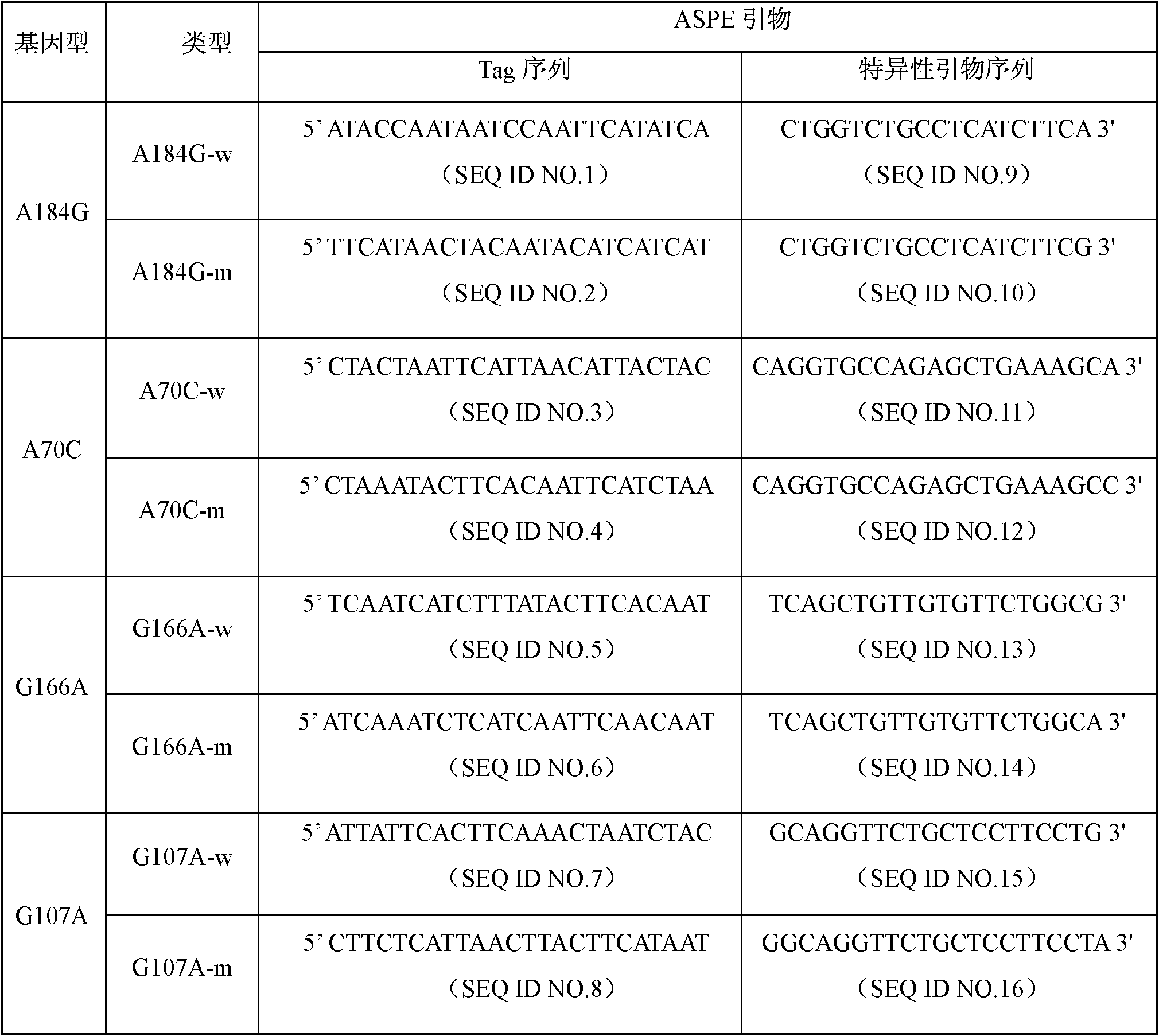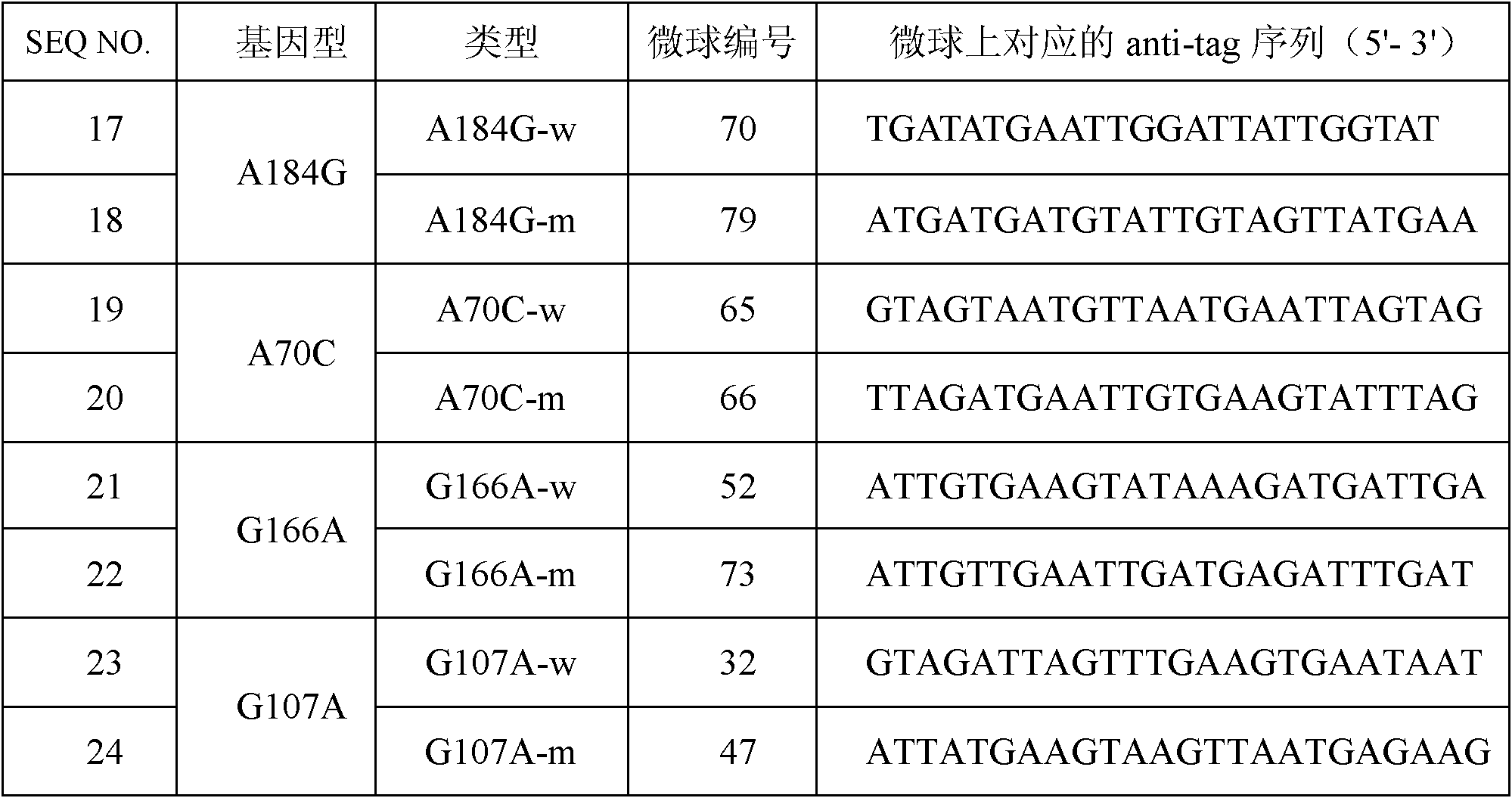KCNQ1 (potassium voltage-gated channel, KQT-like subfamily, member 1), KCNE2 (potassium voltage-gated channel, Isk-like family, member 2) and KCNN3 (calcium-activated potassium (SK) channels) gene SNP (Single Nucleotide Polymorphism) detection specific primer and liquid-phase chip
A technology of KCNE2 and detection solution, which is applied in the fields of medicine and biology, can solve the problems of poor repeatability of detection results, expensive solid-phase chips, and low sensitivity, so as to avoid uncertain factors, good signal-to-noise ratio, and cross-reaction low rate effect
- Summary
- Abstract
- Description
- Claims
- Application Information
AI Technical Summary
Problems solved by technology
Method used
Image
Examples
Embodiment 1
[0023] Embodiment 1 KCNQ1, KCNE2 and KCNN3 gene SNP detection liquid chip mainly includes:
[0024] 1. ASPE Primers
[0025] Specific primer sequences were designed for wild-type and mutant types of four common genotypes A184G, A70C, G166A and G107A of KCNQ1, KCNE2 and KCNN3 genes, respectively. ASPE primers consist of "Tag sequence + specific primer sequence". ASPE primer sequences are shown in the table below:
[0026] The ASPE primer sequence (Tag sequence+specific primer sequence) of table 1 KCNQ1, KCNE2 and KCNN3 gene
[0027]
[0028] Each ASPE primer includes two parts, the 5' end is a specific tag sequence for the anti-tag sequence on the corresponding microsphere, and the 3' end is a mutant or wild-type specific primer fragment (as shown in the above table 1). All ASPE primers were synthesized by Shanghai Sangon Bioengineering Technology Service Co., Ltd. Each synthesized primer was prepared into a stock solution of 100 pmol / mL with 10 mmol / L Tris Buffer.
[0...
Embodiment 2
[0040] Example 2 Detection of samples using KCNQ1, KCNE2 and KCNN3 gene detection liquid chip
[0041] The formula of described various solutions is as follows:
[0042] 50mM MES buffer (pH5.0) formulation (250mL):
[0043]
[0044] 2×Tm hybridization buffer
[0045] Reagent
source
Final concentration
Dosage per 250ml
1M Tris-HCl, pH8.0
Sigma T3038
0.2M
50ml
5M NaCl
Sigma S5150
0.4M
20ml
Triton X-100
Sigma T8787
0.16%
0.4ml
[0046] Store at 4°C after filtration.
[0047] ExoSAP-IT kit was purchased from US USB Company.
[0048] Biotin-labeled dCTP was purchased from Shanghai Sangon Bioengineering Technology Service Co., Ltd.
[0049] 1. Sample DNA extraction
[0050] Refer to the relevant methods of DNA extraction in "Molecular Cloning" to obtain the DNA to be detected.
[0051] 2. PCR amplification of samples to be tested
[0052] Design three pairs of primers, multiplex ...
Embodiment 3
[0108] The liquid phase chip of embodiment 3 different ASPE primers detects KCNQ1, KCNE2 and KCNN3 gene SNP site
[0109] 1. Design of liquid phase chip preparation (selection of Tag sequence and Anti-Tag sequence)
[0110] Taking the KCNQ1 gene A184G site mutation detection liquid chip as an example, the specific primer sequence of the 3' end of the ASPE primer was designed for the wild type and mutant type of A184G, and the Tag sequence at the 5' end of the ASPE primer was selected from SEQ ID NO.1 - SEQ ID NO.8, correspondingly, the anti-tag sequence coated on the microspheres and complementary to the corresponding tag sequence is selected from SEQ ID NO.17-SEQ ID NO.24. The specific design is shown in the following table (Table 7). The synthesis of ASPE primers, microspheres coated with anti-tag sequences, amplification primers, detection methods, etc. are as described in Example 1 and Example 2.
[0111] Table 7 Design of liquid phase chip preparation
[0112]
[01...
PUM
 Login to View More
Login to View More Abstract
Description
Claims
Application Information
 Login to View More
Login to View More - R&D
- Intellectual Property
- Life Sciences
- Materials
- Tech Scout
- Unparalleled Data Quality
- Higher Quality Content
- 60% Fewer Hallucinations
Browse by: Latest US Patents, China's latest patents, Technical Efficacy Thesaurus, Application Domain, Technology Topic, Popular Technical Reports.
© 2025 PatSnap. All rights reserved.Legal|Privacy policy|Modern Slavery Act Transparency Statement|Sitemap|About US| Contact US: help@patsnap.com



